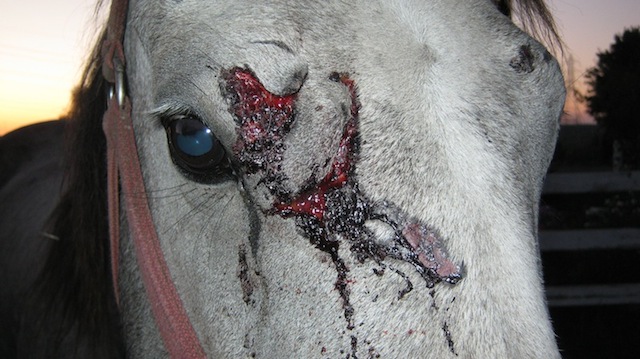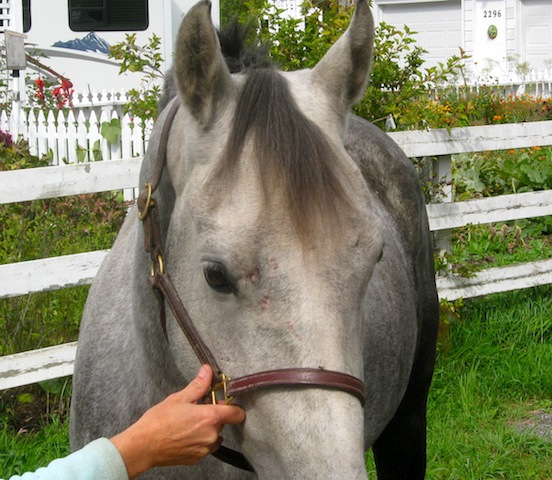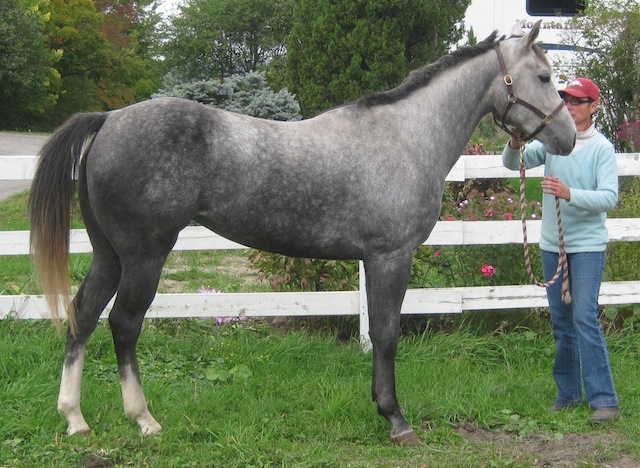The deep gash oozing so darkly across the angelic pale face of the nameless filly, riveted Mindy Lovell’s attention the way a red flag might a bull.
In the five years she’d spent rescuing Thoroughbreds from slaughter, Lovell had seen things, unimaginable things: She’d witnessed horses arriving dead in shipping trucks, trampled by other terrified horses; Pregnant mares laboring through spontaneous abortions in transport, and injuries so horrible that once regal Thoroughbreds hobbled like cripples.
But on this day as she witnessed the dappled-gray filly with the bludgeoned face, it seemed to crystallize all that she’d seen before, chasing after Thoroughbreds, who themselves, were racing hopelessly down.
Originally published on Nov. 20, 2012One more beautiful horse, like something out of a child’s fantasy, bleeding profusely from the battering she took en-route to slaughter.
“I saw that filly as soon as I got out of the car, and I knew I would pull her out,” Lovell says. “It wasn’t even really a decision. She needed emergency veterinary care; she needed to be stitched up before it was too late!”
In a way, the gray filly she saved on Aug. 27 is every horse.
Just one of so many, shipped in open trailers with aluminum floors made slippery by feces and urine. The animals kick and fight, and sometimes fall, injuring themselves as badly, or worse, than this one.
But unlike the ex-racehorse Thoroughbreds so easily identified by lip tattoos and physical appearance, this frightened animal was just a face in the crowd.
Until she started to bleed.
That’s when Lovell decided to jump in yet one more time.
Having already taken three other off-track Thoroughbreds, and not needing another to add to her herd of 47 horses, Lovell did not hesitate to claim the trembling animal.
“I asked a local livestock hauler … to bring them all over to my farm, and I had already called my vet to let them know I would have an emergency later,” she says. “They joked with me that it was the first time they’d received a ‘heads up’ on an emergency! So I said they should stick with me because I really know how to have fun.
“I won’t get into the part where the vet nearly passed out onto the floor over the sight of the filly’s face.”
Lovell has been in the trenches of horse rescue for five years now. Some days she feels like giving up, or at least buying stock in Kleenex, she says. But, then the anger kicks in, and she returns again and again to look for more desperate souls.
“There was a time, years ago, when you only saw Thoroughbreds running through a kill auction if they were completely crippled,” says the longtime equestrian and riding instructor. “But everything changed. Thoroughbreds became less popular as riding horses and so you started seeing many, many sound, useful horses going to auction.”
Lovell, who owns Spring Hill Farm and runs the Transitions Thoroughbred Program, to re-train ex-racehorses, was happily enjoying her life as competitive rider, coach and trainer when, she says, her involvement with the horse world’s ugly side came about.
“I’d been managing and running a boarding facility and doing a lot of teaching. And I started to acquire more Thoroughbreds to retrain for a second career,” she says. “It naturally evolved that I started looking at slaughter-bound horses.
“So, I’d be looking at these horses, even if they were emaciated. I have a really good eye, and I’d think, ‘Wow, this horse has a lot of potential.’ And then I’d think, ‘What the hell is this horse doing here?’ ” And she knew that too many fine-quality horses were being slaughtered.
Of her herd of 47, approximately 80 percent were pulled from slaughter pens. Of those, fewer than 10 have minor soundness issues; the rest are perfectly sound.
For many years, Lovell pulled horses from kill pens, re-trained and re-sold them. She always kept a low profile. Few were even aware she was doing it.
But in the past year or so, Lovell started working on some high-profile horse-slaughter stories, including that of Deputy Broad, who was slaughtered, and the well-known OTTBs Cactus Cafe and Canuki, who were eventually saved from the slaughter pipeline.
She has also heavily lobbied Canadian slaughterhouses to ban imports of American Thoroughbreds, arguing that most American racehorses have been treated with medications and substances that are banned in foods consumed by humans.
It’s exhausting work. It’s invigorating work. Sometimes it “pushes her over the edge.”
“It’s outrageous to me that it is the industry of horse racing that is making money off these horses, yet most of the people who try to help them are people who can’t really afford it.
“I know an exercise rider and her mother who solicited donations to help a horse I recently pulled. They can’t afford it,” she says. “Yet, the industry itself has yet to really step up.”
Always wrestling with the decision of who to save, the reward of saving some, keeps her outlook mostly positive.
The gray filly is recuperating in body and spirit. The wound on her face has closed, and the fear in her heart seems to be easing. She also has a name now—it’s Glenye, named for journalist Glenye Oakford, who wrote the articles about Cactus Cafe and Canuki for the Daily Racing Form.
She no longer runs to the back of her stall when people approach, wincing as though she’d done something wrong. She has filled out nicely and looks to be a Warmblood-type mover, Lovell says.
But she is still a scared horse, and Lovell will take it very slowly as she trains her to become potentially, a show horse. A once bludgeoned and battered, no-name gray in the show ring!
These are the stories that sustain Lovell through her heartbreaking work.
“We can’t save them all,” Lovell says. “And I don’t know what the answer is or where it’s going to end. I just know I have to try.”





A truly amazing woman – Mindy you are such an inspiration, an animal angel in every sense of the word. So happy you managed to save her, she is beautiful – if only they could all be saved! It is so despicable of us humans to inflict these horrendous atrocities on innocent, voiceless and defenceless animals – 99% of mankind is truly a disgrace!
Hi, Susan! Thank you so much for spotlighting Mindy Lovell’s great work and Glenye the horse–what an honor to have her as a namesake! (and hello, Fran Jurga!)
Glenye,
Thanks for reading the story! I have a very cool update coming soon on your namesake!!
I am glad to see stories like this. I guess I was wrong about not seeing any mention about horse slaughter on this site. I haven’t been receiving this news letter very long. I have been in the fight against horse slaughter for ten years, I am hoping that the long fight may be coming to a end. There are several lawsuits being filed against the USDA over them giving the red light to several horse slaughter plants in several states that the USDA will provide meat inspectors.
God bless all of you and your selfless endeavor to rescue these forgotten beauties! Ppl tend to just throw away animals…I don’t understand! Thank you for all you, how can I help you?
God knew what he was doing when he guided this Angel of Mercy, Mindy, to the horses who need her courage and dedication to save them. The horrors of slaughter should shock everyone into action. I’m amazed at how many people are unaware of horse slaughter, let alone knowing the horrific stories. I have 8 horses, mostly retired TBs that we raced, that I have kept because I fear what will happen to them if they leave my care. My gratitude to all of those who step in to rescue and protect those horses who are headed to a dreadful end.
She’s beautiful! Thanks for all that you do! I wish I could help.
Thank-You so much for caring about the TB’s, you are a great person. You are right, the ones who care are the ones who can not afford it. I am one of them. I am spend the majority of my military retirement on saving horses from slaughter abuse and neglect. I am not sure how much longer I can do it, having 15 rescues now is draining me. Trying to become a 501 c3 but taking longer than expected. I pray for Americas horse often, especially the wild mustangs.
I’m sure I remember seeing the before picture of her poor bleeding face. I am so very grateful to read that she is safe in the loving care of Mindy. It makes me so sick to think of all those who were not saved, OTTB or not.
I hope she is progressing towards a total recovery. No horse deserved this.
Thanks for reposting this story, I guess I missed it the first time. What an inspiration!
And how great to be named after Glenye Oakford!
Aw Fran, thanks!
“We cannot save them all.”
Heartbreaking because it’s true.
However, “we” do what we can, actually taking in horses in need or supporting organizations and activities that shine lights on the fabulous athletes that await a second career when their time either preparing to be racehorses or actually racing is over.
Lucky Glenye and those who are “poster ponies” for a worthy cause and the often unheralded superstars who are doing everything they can to further the cause of saving Thoroughbreds with nowhere to go.